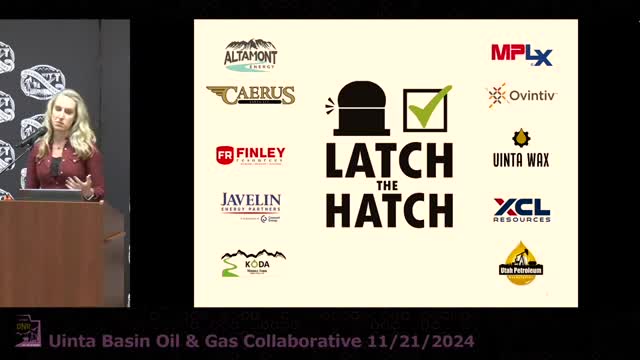Innovative program tackles emissions in oil and gas industry
November 22, 2024 | Utah Department of Natural Resources, Utah Government Divisions, Utah Legislative Branch, Utah
This article was created by AI summarizing key points discussed. AI makes mistakes, so for full details and context, please refer to the video of the full meeting. Please report any errors so we can fix them. Report an error »

In a recent government meeting, officials highlighted significant strides made in improving air quality through the Latch to Hatch program, which targets emissions from the oil and gas industry. The initiative, launched three years ago, focuses on closing \"thief hatches\"—a common source of emissions—and has expanded to include a variety of voluntary commitments from major producers in the region.
The program has seen impressive growth, with over 400 sites now equipped with sensors to monitor emissions, a substantial increase from just a few sites in 2022. Additionally, the use of aerial flyovers to identify leaks has become a regular practice among the largest producers, contributing to a proactive approach in addressing emissions.
Key metrics from the program reveal that nearly 1,000 sites are now fully powered by solar energy, alongside hundreds of retrofitted pumps and removed pneumatic controllers, all aimed at reducing the environmental impact of operations. The meeting underscored the importance of these efforts, particularly as the region prepares for the winter season, which poses unique challenges for air quality.
Looking ahead, officials emphasized the need to incorporate electrification into their strategies to further reduce emissions and support continued growth in the basin. The Latch to Hatch program is set to evolve, with plans to track new metrics and expand its scope to include additional emission reduction opportunities.
As the winter season approaches, stakeholders are encouraged to utilize a checklist of actions designed to minimize emissions during critical ozone events, reinforcing the collaborative commitment to improving air quality in the region.
The program has seen impressive growth, with over 400 sites now equipped with sensors to monitor emissions, a substantial increase from just a few sites in 2022. Additionally, the use of aerial flyovers to identify leaks has become a regular practice among the largest producers, contributing to a proactive approach in addressing emissions.
Key metrics from the program reveal that nearly 1,000 sites are now fully powered by solar energy, alongside hundreds of retrofitted pumps and removed pneumatic controllers, all aimed at reducing the environmental impact of operations. The meeting underscored the importance of these efforts, particularly as the region prepares for the winter season, which poses unique challenges for air quality.
Looking ahead, officials emphasized the need to incorporate electrification into their strategies to further reduce emissions and support continued growth in the basin. The Latch to Hatch program is set to evolve, with plans to track new metrics and expand its scope to include additional emission reduction opportunities.
As the winter season approaches, stakeholders are encouraged to utilize a checklist of actions designed to minimize emissions during critical ozone events, reinforcing the collaborative commitment to improving air quality in the region.
View full meeting
This article is based on a recent meeting—watch the full video and explore the complete transcript for deeper insights into the discussion.
View full meeting

